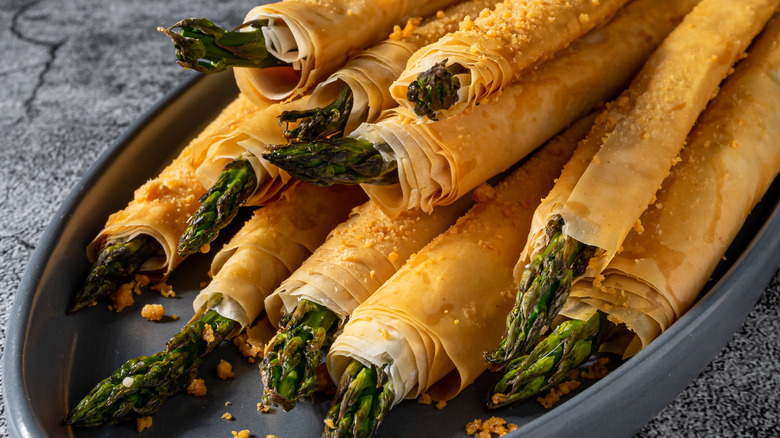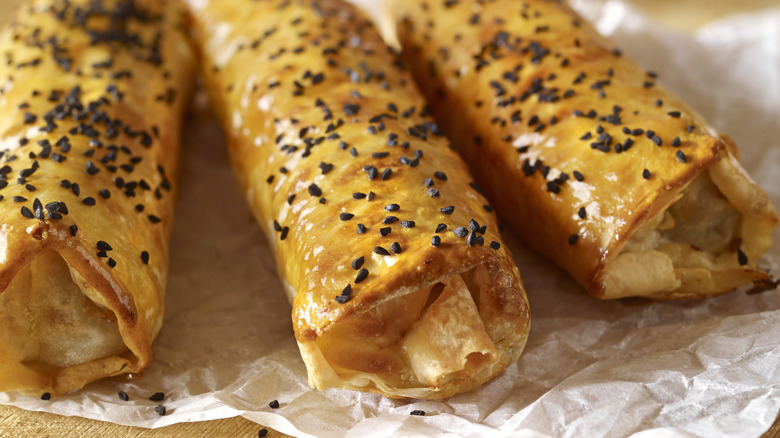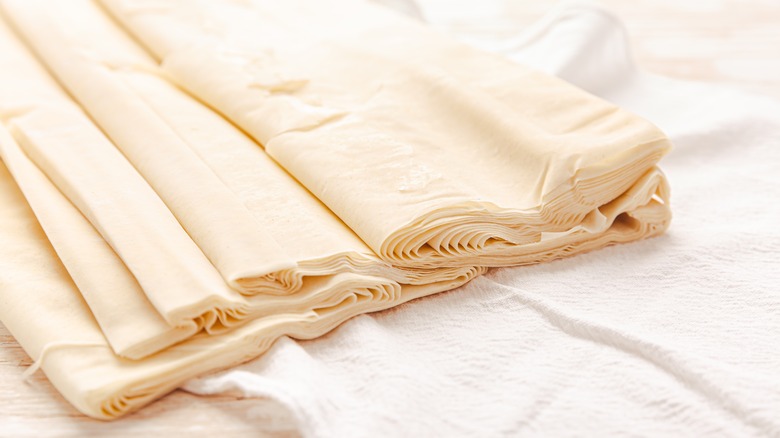Wrap Your Veggies In Phyllo Dough For A Crispy Bite
Crunchy, delicate phyllo dough is woefully underused. For typically less than $10, you can buy sheets of the prepared ingredient and find a place for it in every meal where the paper-thin dough will bake up quickly and deepen into a caramelized golden brown.
Best of all, the floury ingredient is neither sweet nor savory, making it all the more versatile. So, on busy weeknights, count on phyllo to turn leftover roasted vegetables into a brand-new dish. Even mashed potatoes can get a second life when encased by the flaky pastry. Or start from scratch, and use the dough to cook up fresh produce lingering in the fridge.
All you have to do is brush a sheet of the dough with butter and roll up a strip of pepper, spear of asparagus, or a thin wedge of carrot. Depending on the size of your vegetables, you may choose to halve the sheets or fold them and brush with fat once again before rolling. You can bake the bites in the oven or air fryer, at 350-375 degrees Fahrenheit, for roughly 10-20 minutes. This timing will vary depending on the thickness of the ingredients and if you choose to blanch them before cooking.
Dressing up wrapped vegetables
When toasted, phyllo shatters and adds texture to every bite. It's also a vessel for global flavors, strong seasonings, and creative combinations. Though you can keep wrapped vegetables simple to highlight their earthy sweetness, we suggest taking inspiration from other pastries.
Start with the filling. Tip the meal firmly into savory territory with a crumble of salty feta or a creamy smear of feta mixed with egg, reminiscent of a borek or cheese cigar. Consider using up any herbs, like dill or parsley, as well. If you're a breakfast-for-dinner type, break all the rules and add just-scrambled eggs to give the rolls a breakfast burrito quality. You can also serve the finger food alongside a yogurt sauce to add moisture.
And, don't forget to brush the tops of the packets with butter and season them, too. To infuse a nutty note, copy a common pairing often seen with the dough: sesame seeds. The white and black seeds will add visual contrast and a warm aroma to your baked meal. For a more striking flavor, incorporate nigella seeds, a popular topping that delivers a deliciously sharp savory scent. Or add a shake of pungent everything bagel spice for a little of ... everything.
Working with phyllo dough
Using phyllo dough in this manner is a great way to use up leftover sheets after you've baked up a Greek spiral spanakopita, or to get to know the ingredient if it's your first time using it. First, though, make sure to defrost a roll of the dough — or the whole box — in the fridge overnight before you're ready to cook it. It takes longer than you think, but it's worth waiting to ensure the pastry will be supple and flexible, rather than brittle.
When setting up your station, consider draping a damp towel over the layers you're not working with, since they're prone to drying out. We're the first to admit that brushing the dough with oil or butter is a challenge. But keep with it and stay patient. The sheets are made without fat, so this step is essential to keep the crispy bake moist and caramelized. Technically, you can use an aerosol spray, but you'll get the best results with a pastry brush and a liquid.
Baked phyllo freezes well, so feel free to go overboard. If you hit your stride but run out of vegetables, consider baking up crackers to accompany the meal. Just add shredded cheese and spices to the tops of the buttery layers and roast until golden.



